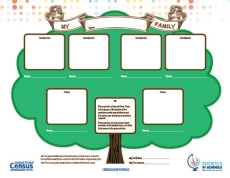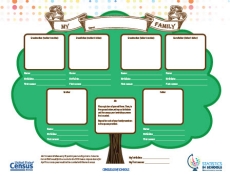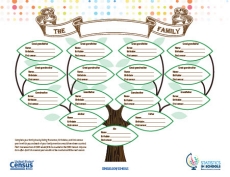My Family Tree
The U.S. Census Bureau counts the population of the United States every 10 years in years ending in zero. On April 1, 2022, the National Archives and Records Administration (NARA) released the 1950 Census population records. Highlighting our commitment to confidentiality, NARA does not share records with anyone until 72 years after the census.
Did you know the 2020 Census showed 331 million people live in the United States, a 119 percent increase from 151 million in 1950?
Censuses are a great source of information that can help fill in gaps about family histories (ancestry). They provide data about people living in U.S. households such as surnames, ages, relationships, and ethnicities. A family tree is a popular format used to tell the story of who we are.
This activity includes worksheets students at different grade levels can use to construct their own family trees and to record the first census year in which they and their family members would have been counted. For example, if someone’s grandparent was born in 1945, the first census year in which they would have been counted is 1950. Also, if someone is born after April 1 in a census year, they would not be counted until the next census a decade later.
Pictographic Family Tree (Traditional and Alternative Versions)
Elementary school students can use this pictographic family tree worksheet to trace their ancestry back to their grandparents by affixing pictures of their family members to it and recording their names. Teachers can help students figure out the first census year they would have been counted in based on their birthdates. The 2020 Census will be the first census for most elementary school students. Suggestion: In preparation for this activity, ask students to bring in names and copies of original images of their family members, and to make sure they know their own birthdates (day/month/year).
Detailed Pictographic Family Tree (Traditional and Alternative Versions)
Middle school students can use this detailed pictographic family tree worksheet to trace their ancestry back to their grandparents by affixing pictures of family members and recording the names, birthdates, and first census years in which each would have been counted. Suggestion: In preparation for this activity, ask students to bring in names, birthdates (day/month/year) and copies of original images of their family members.
Leaf Family Tree (Traditional and Alternative Versions)
High school students can use this leaf family tree worksheet to trace their ancestry back to their great-grandparents by recording the names, birthdates, and first census year in which they and each family member would have been counted. Suggestion: In preparation for this activity, ask students to gather the names and birthdates (day/month/year) of their family members.







